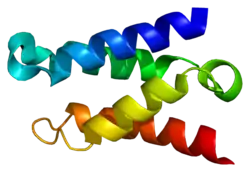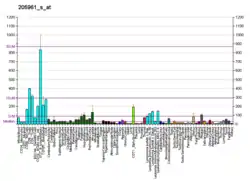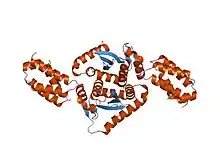PSIP1
PC4 and SFRS1 interacting protein 1, also known as lens epithelium-derived growth factor (LEDGF/p75), dense fine speckles 70kD protein (DFS 70) or transcriptional coactivator p75/p52, is a protein that in humans is encoded by the PSIP1 gene.[5][6]
Function
PSIP1 has not been clearly linked to a specific cellular mechanism. The term LEDGF/p75 (Lens epithelium-derived growth factor) has entered common usage based on the initial characterization of PSIP1, however this is a misnomer, as the protein is present in most tissues and has no direct role in the development of lens epithelium. LEDGF/p75, a transcription coactivator, gained prominence as a host factor that assists HIV integration[7] and is probably the only integrase interactor whose knock-down severely affects the HIV integration levels.[8][9][10] The interaction between HIV integrase and human LEDGF/p75 is a promising target for anti-HIV drug discovery.[11] LEDGF/p75 recruits MLL complexes to HOX genes to regulate their expression.[12] LEDGF/p52 is shown to recruit splicing factors to H3K36 trimethylated chromatin to modulate alternative splicing,[13] also regulates HOTTIP lncRNA, which is shown to regulate HOX genes in cis.[14]
Structure
LEDGF/p75 is a 60kDa, 530-amino-acid-long protein.[15] The N-terminal portion of the protein consists of a PWWP domain, a nuclear localization sequence, and two copies of the AT-hook DNA binding motif. The C-terminal portion of LEDGF/p75 contains a structure termed the integrase-binding domain,[16] which interacts with lentiviral integrase proteins as well as numerous cellular proteins. The N-terminal portion interacts strongly with chromatin, making LEDGF/p75 a constitutively nuclear protein. An isoform of the protein, LEDGF/p52, is produced by alternative splicing. LEDGF/p52 shares the N-terminal 325 amino acids of LEDGF/p75 but lacks the integrase-binding domain.
Interactions
PSIP1 has been shown to interact with the proteins ASF/SF2, JPO2, Cdc7-Dbf4, and POGZ as well as the menin/MLL protein complex.[17][18]
References
- GRCh38: Ensembl release 89: ENSG00000164985 - Ensembl, May 2017
- GRCm38: Ensembl release 89: ENSMUSG00000028484 - Ensembl, May 2017
- "Human PubMed Reference:". National Center for Biotechnology Information, U.S. National Library of Medicine.
- "Mouse PubMed Reference:". National Center for Biotechnology Information, U.S. National Library of Medicine.
- "Entrez Gene: PSIP1 PC4 and SFRS1 interacting protein 1".
- Singh DP, Kimura A, Chylack LT, Shinohara T (January 2000). "Lens epithelium-derived growth factor (LEDGF/p75) and p52 are derived from a single gene by alternative splicing". Gene. 242 (1–2): 265–73. doi:10.1016/S0378-1119(99)00506-5. PMID 10721720.
- Cherepanov P, Maertens G, Proost P, Devreese B, Van Beeumen J, Engelborghs Y, De Clercq E, Debyser Z (January 2003). "HIV-1 integrase forms stable tetramers and associates with LEDGF/p75 protein in human cells". J. Biol. Chem. 278 (1): 372–81. doi:10.1074/jbc.M209278200. PMID 12407101.
- Vandekerckhove L, Christ F, Van Maele B, De Rijck J, Gijsbers R, Van den Haute C, Witvrouw M, Debyser Z (February 2006). "Transient and stable knockdown of the integrase cofactor LEDGF/p75 reveals its role in the replication cycle of human immunodeficiency virus". J. Virol. 80 (4): 1886–96. doi:10.1128/JVI.80.4.1886-1896.2006. PMC 1367129. PMID 16439544.
- Shun MC, Raghavendra NK, Vandegraaff N, Daigle JE, Hughes S, Kellam P, Cherepanov P, Engelman A (July 2007). "LEDGF/p75 functions downstream from preintegration complex formation to effect gene-specific HIV-1 integration". Genes Dev. 21 (14): 1767–78. doi:10.1101/gad.1565107. PMC 1920171. PMID 17639082.
- Llano M, Saenz DT, Meehan A, Wongthida P, Peretz M, Walker WH, Teo W, Poeschla EM (October 2006). "An essential role for LEDGF/p75 in HIV integration". Science. 314 (5798): 461–4. Bibcode:2006Sci...314..461L. doi:10.1126/science.1132319. PMID 16959972. S2CID 24756699.
- Christ F, Voet A, Marchand A, Nicolet S, Desimmie BA, Marchand D, Bardiot D, Van der Veken NJ, Van Remoortel B, Strelkov SV, De Maeyer M, Chaltin P, Debyser Z (June 2010). "Rational design of small-molecule inhibitors of the LEDGF/p75-integrase interaction and HIV replication". Nat. Chem. Biol. 6 (6): 442–8. doi:10.1038/nchembio.370. PMID 20473303.
- Pradeepa, Madapura M.; Grimes, Graeme R.; Taylor, Gillian C. A.; Sutherland, Heidi G.; Bickmore, Wendy A. (2014-08-18). "Psip1/Ledgf p75 restrains Hox gene expression by recruiting both trithorax and polycomb group proteins". Nucleic Acids Research. 42 (14): 9021–9032. doi:10.1093/nar/gku647. ISSN 0305-1048. PMC 4132756. PMID 25056311.
- Pradeepa, Madapura M.; Sutherland, Heidi G.; Ule, Jernej; Grimes, Graeme R.; Bickmore, Wendy A. (2012-05-17). "Psip1/Ledgf p52 Binds Methylated Histone H3K36 and Splicing Factors and Contributes to the Regulation of Alternative Splicing". PLOS Genetics. 8 (5): e1002717. doi:10.1371/journal.pgen.1002717. ISSN 1553-7404. PMC 3355077. PMID 22615581.
- Pradeepa, Madapura M.; McKenna, Fionnuala; Taylor, Gillian C. A.; Bengani, Hemant; Grimes, Graeme R.; Wood, Andrew J.; Bhatia, Shipra; Bickmore, Wendy A. (2017-04-06). "Psip1/p52 regulates posterior Hoxa genes through activation of lncRNA Hottip". PLOS Genetics. 13 (4): e1006677. doi:10.1371/journal.pgen.1006677. ISSN 1553-7404. PMC 5383017. PMID 28384324.
- Llano M, Morrison J, Poeschla EM (2009). "Virological and cellular roles of the transcriptional coactivator LEDGF/p75". HIV Interactions with Host Cell Proteins. Curr. Top. Microbiol. Immunol. Current Topics in Microbiology and Immunology. 339. pp. 125–46. doi:10.1007/978-3-642-02175-6_7. ISBN 978-3-642-02174-9. PMC 3093762. PMID 20012527.
- Cherepanov P, Sun ZY, Rahman S, Maertens G, Wagner G, Engelman A (June 2005). "Solution structure of the HIV-1 integrase-binding domain in LEDGF/p75". Nat. Struct. Mol. Biol. 12 (6): 526–32. doi:10.1038/nsmb937. PMID 15895093. S2CID 20898124.
- Ge H, Si Y, Wolffe AP (December 1998). "A novel transcriptional coactivator, p52, functionally interacts with the essential splicing factor ASF/SF2". Mol. Cell. 2 (6): 751–9. doi:10.1016/S1097-2765(00)80290-7. PMID 9885563.
- Hughes S, Jenkins V, Dar MJ, Engelman A, Cherepanov P (January 2010). "Transcriptional co-activator LEDGF interacts with Cdc7-activator of S-phase kinase (ASK) and stimulates its enzymatic activity". J. Biol. Chem. 285 (1): 541–54. doi:10.1074/jbc.M109.036491. PMC 2804203. PMID 19864417.
Further reading
- Shun MC, Raghavendra NK, Vandegraaff N, Daigle JE, Hughes S, Kellam P, Cherepanov P, Engelman A (July 2007). "LEDGF/p75 functions downstream from preintegration complex formation to effect gene-specific HIV-1 integration". Genes Dev. 21 (14): 1767–78. doi:10.1101/gad.1565107. PMC 1920171. PMID 17639082.
- Van Maele B, Debyser Z (2005). "HIV-1 integration: an interplay between HIV-1 integrase, cellular and viral proteins". AIDS Rev. 7 (1): 26–43. PMID 15875659.
- Van Maele B, Busschots K, Vandekerckhove L, Christ F, Debyser Z (2006). "Cellular co-factors of HIV-1 integration". Trends Biochem. Sci. 31 (2): 98–105. doi:10.1016/j.tibs.2005.12.002. PMID 16403635.
- Freed EO, Mouland AJ (2006). "The cell biology of HIV-1 and other retroviruses". Retrovirology. 3: 77. doi:10.1186/1742-4690-3-77. PMC 1635732. PMID 17083721.
- Ge H, Si Y, Roeder RG (1998). "Isolation of cDNAs encoding novel transcription coactivators p52 and p75 reveals an alternate regulatory mechanism of transcriptional activation". EMBO J. 17 (22): 6723–9. doi:10.1093/emboj/17.22.6723. PMC 1171017. PMID 9822615.
- Ge H, Si Y, Wolffe AP (1998). "A novel transcriptional coactivator, p52, functionally interacts with the essential splicing factor ASF/SF2". Mol. Cell. 2 (6): 751–9. doi:10.1016/S1097-2765(00)80290-7. PMID 9885563.
- Singh DP, Ohguro N, Kikuchi T, Sueno T, Reddy VN, Yuge K, Chylack LT, Shinohara T (2000). "Lens epithelium-derived growth factor: effects on growth and survival of lens epithelial cells, keratinocytes, and fibroblasts". Biochem. Biophys. Res. Commun. 267 (1): 373–81. doi:10.1006/bbrc.1999.1979. PMID 10623627.
- Singh DP, Kimura A, Chylack LT, Shinohara T (2000). "Lens epithelium-derived growth factor (LEDGF/p75) and p52 are derived from a single gene by alternative splicing". Gene. 242 (1–2): 265–73. doi:10.1016/S0378-1119(99)00506-5. PMID 10721720.
- Ochs RL, Muro Y, Si Y, Ge H, Chan EK, Tan EM (2000). "Autoantibodies to DFS 70 kd/transcription coactivator p75 in atopic dermatitis and other conditions". J. Allergy Clin. Immunol. 105 (6 Pt 1): 1211–20. doi:10.1067/mai.2000.107039. PMID 10856157.
- Kubo E, Fatma N, Sharma P, Shinohara T, Chylack LT, Akagi Y, Singh DP (2002). "Transactivation of involucrin, a marker of differentiation in keratinocytes, by lens epithelium-derived growth factor (LEDGF)". J. Mol. Biol. 320 (5): 1053–63. doi:10.1016/S0022-2836(02)00551-X. PMID 12126624.
- Wu X, Daniels T, Molinaro C, Lilly MB, Casiano CA (2002). "Caspase cleavage of the nuclear autoantigen LEDGF/p75 abrogates its pro-survival function: implications for autoimmunity in atopic disorders". Cell Death Differ. 9 (9): 915–25. doi:10.1038/sj.cdd.4401063. PMID 12181742.
- Cherepanov P, Maertens G, Proost P, Devreese B, Van Beeumen J, Engelborghs Y, De Clercq E, Debyser Z (2003). "HIV-1 integrase forms stable tetramers and associates with LEDGF/p75 protein in human cells". J. Biol. Chem. 278 (1): 372–81. doi:10.1074/jbc.M209278200. PMID 12407101.
- Maertens G, Cherepanov P, Pluymers W, Busschots K, De Clercq E, Debyser Z, Engelborghs Y (2003). "LEDGF/p75 is essential for nuclear and chromosomal targeting of HIV-1 integrase in human cells". J. Biol. Chem. 278 (35): 33528–39. doi:10.1074/jbc.M303594200. PMID 12796494.
- Maertens G, Cherepanov P, Debyser Z, Engelborghs Y, Engelman A (2004). "Identification and characterization of a functional nuclear localization signal in the HIV-1 integrase interactor LEDGF/p75". J. Biol. Chem. 279 (32): 33421–9. doi:10.1074/jbc.M404700200. PMID 15163664.
- Beausoleil SA, Jedrychowski M, Schwartz D, Elias JE, Villén J, Li J, Cohn MA, Cantley LC, Gygi SP (2004). "Large-scale characterization of HeLa cell nuclear phosphoproteins". Proc. Natl. Acad. Sci. U.S.A. 101 (33): 12130–5. Bibcode:2004PNAS..10112130B. doi:10.1073/pnas.0404720101. PMC 514446. PMID 15302935.
- Llano M, Vanegas M, Fregoso O, Saenz D, Chung S, Peretz M, Poeschla EM (2004). "LEDGF/p75 determines cellular trafficking of diverse lentiviral but not murine oncoretroviral integrase proteins and is a component of functional lentiviral preintegration complexes". J. Virol. 78 (17): 9524–37. doi:10.1128/JVI.78.17.9524-9537.2004. PMC 506940. PMID 15308744.
- Cherepanov P, Devroe E, Silver PA, Engelman A (2004). "Identification of an evolutionarily conserved domain in human lens epithelium-derived growth factor/transcriptional co-activator p75 (LEDGF/p75) that binds HIV-1 integrase". J. Biol. Chem. 279 (47): 48883–92. doi:10.1074/jbc.M406307200. PMID 15371438.
- Llano M, Delgado S, Vanegas M, Poeschla EM (2004). "Lens epithelium-derived growth factor/p75 prevents proteasomal degradation of HIV-1 integrase". J. Biol. Chem. 279 (53): 55570–7. doi:10.1074/jbc.M408508200. PMID 15475359.
- Ogawa Y, Sugiura K, Watanabe A, Kunimatsu M, Mishima M, Tomita Y, Muro Y (2004). "Autoantigenicity of DFS70 is restricted to the conformational epitope of C-terminal alpha-helical domain". J. Autoimmun. 23 (3): 221–31. doi:10.1016/j.jaut.2004.07.003. PMID 15501393.
- Okamoto M, Ogawa Y, Watanabe A, Sugiura K, Shimomura Y, Aoki N, Nagasaka T, Tomita Y, Muro Y (2004). "Autoantibodies to DFS70/LEDGF are increased in alopecia areata patients". J. Autoimmun. 23 (3): 257–66. doi:10.1016/j.jaut.2004.07.004. PMID 15501396.









